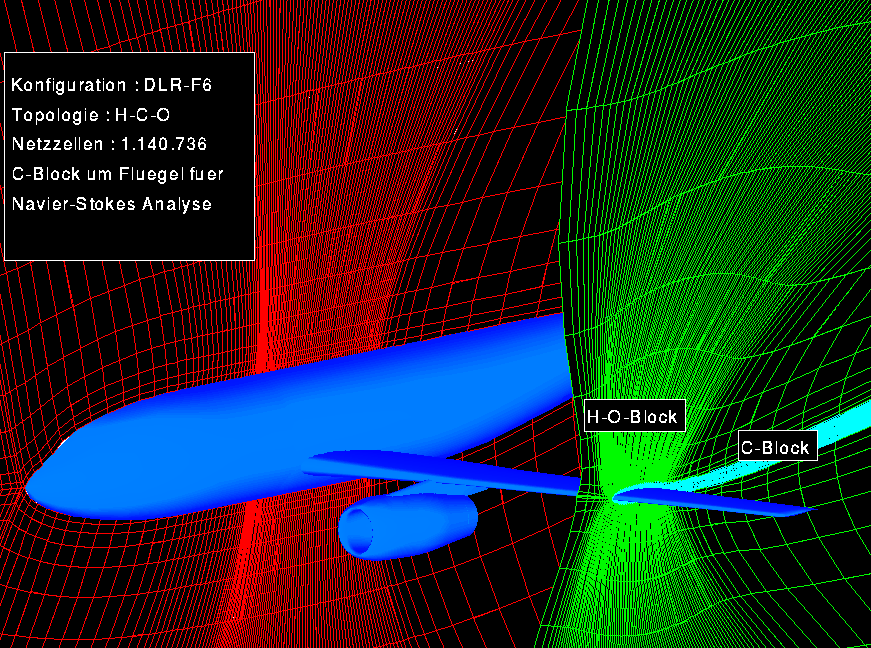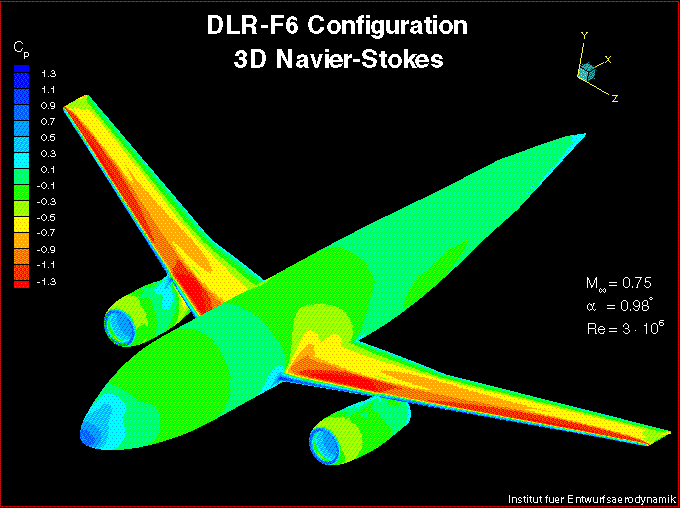
Schematic representation of a block-structured grid in a threedimensional flow simulation

by Anton Schüller and Barbara Steckel
POPINDA is a German national project, funded by the German Federal Ministry for Education, Science, Research and Technology. Its central goal is to provide the utilization of highly parallel systems for aerodynamic production codes. The parallel codes being developed in the project are based on highly efficient numerical algorithms (multigrid). They will allow more accurate simulations, which are indispensable due to increased economic, ecologic and technical requirements.
For the development of modern aircraft, the simulation of aerodynamic processes is of hgreat economic importance. Many aerodynamic phenomena cannot be solved experimentally at all or only at a considerable amount of cost and time. Therefore, the field of theoretical and computational fluid dynamics has a long history. Due to increased requirements for high-quality simulations resulting in steadily growing CPU-times it is absolutely necessary to make the innovative step to parallel computing.
The project partners in POPINDA are Daimler-Benz Aerospace (with groups at Manching and Munich), Daimler-Benz Aerospace Airbus (Bremen), Deutsche Forschungsanstalt für Luft- und Raumfahrt (Braunschweig), GMD (Sankt Augustin), IBM (Heidelberg) and ORCOM Rechenzentrum GmbH (Freiberg). The project is led by the Institute for Algorithms and Scientific Computing of GMD. It started in July 1993 and will terminate in June 1996. In POPINDA, portable parallel aerodynamic codes are being implemented, tested and upgraded for productional use. A typical application is the numerical simulation of the flow around a complete aircraft. The development of the parallel codes FLOWer (grid point oriented discretization) and NSFLEX (cell centered discretization) is based on the existing sequential three dimensional production codes for flow simulation (CEVCATS, IKARUS, MELINA, NSFLEX) of the aerodynamic partners. These initial codes for POPINDA have been used regularly by the industry for the design and optimization of aircrafts.

In order to gain a further substantial reduction of computing time, the parallel codes will be generalized to dynamic adaptive grid structures in the final year of the project.
Since all sequential codes are based on block-structured grids, the underlying parallelization strategy is the well known approach of grid partitioning. The development of the 3D block-structured communications library CLIC (Communications Library for Industrial Codes) guarantees a unifying and efficient parallelization of the given codes. CLIC provides subroutines for all communications tasks occurring in multiblock block-structured applications and creates a de-facto standard for parallelization of such applications. It will be also an important tool for the parallelization of other codes coming from computational fluid dynamics or other areas that employ block-structured grids. The portability of the communications library and thus of the parallelized codes is achieved by the use of portable message passing interfaces; both, PARMACS and Message Passing Interface versions of the Communications Library for Industrial Codes will be made available.

An efficient parallelization of such complex industrial applications requires solutions of fundamental algorithmic questions. Corresponding research and development in order to maintain the typical high numerical efficiency of multigrid and to achieve high parallel efficiency and scalability are important issues in the project.
At the project half-way point, first results are already available. In particular, the high efficiency and scalability of the current versions of the parallel codes could be demonstrated for realistic test cases on different parallel systems.
The results of POPINDA will form a basis for further algorithmic developments in computational fluid dynamics. This is especially true for the use of more flexible grid and data structures, such as the combination of structured and unstructured grids or overlapping grids.